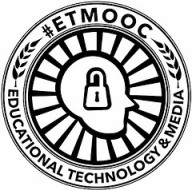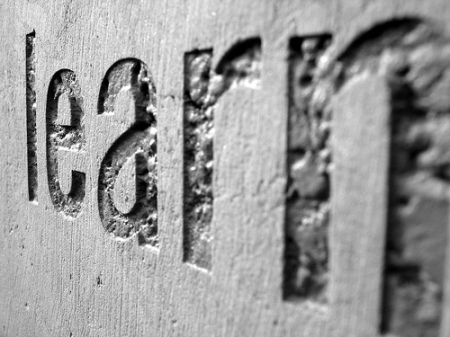This post describes how educators can develop a personal learning network that supports meaningful and relevant learning. The MOOC, Education Technology & Media, etmooc, is used here as a working example of how to develop a PLN.
“My Personal Learning Network is the key to keeping me up-to-date with all the changes that are happening in education and how technology can best support and engage today’s students.” Brian Metcalfe: teacher, blogger at lifelonglearners.com

A visual image of participants in an open, online course- etmooc, which shows the potential to find and create personal connections as part of one’s PLN. (image credit: Alec Couros)
I wrote a post recently about how to develop a personal learning environment [PLE], the need and benefits of doing so, for educators in particular. A PLE is a self-directed learning space; a virtual framework that consists of tools to collect, curate and construct knowledge that is customized to an individual’s learning goals and interests.
What is a PLN?
Another dimension of the PLE is the personal learning network [PLN]. Though the two are often used interchangeably there is a difference. A PLN is an aspect of PLEs, where the individual has a group of people within his or her virtual professional network, and the relationship with each is based upon a common interest, collaborative project or research. Communication and connections are made via social platforms or other Web applications, with the primary intent of sharing or gathering information. Both the PLE and PLN are based on the theory of connectivism, a learning theory conceptualized by George Siemens and Stephen Downes. The premise of connectivism is that the learner connects with nodes [connection points that deliver content or facilitate interaction] within a network, and subsequently develops knowledge through this series of connections.
PLN versus PLE
The personal learning network can be a rich source of learning that fosters connections that become part of our professional development as the quotation at the beginning of the post from Metcalfe describes. Yet building a PLN takes time, energy and purposeful actions, which is why I find it helpful to delineate the two concepts. A PLE can be created independently, building and collecting content sources from the Web, including creating content through blogs, podcasts, Slideshares, etc. A natural extension of one’s PLE is the development of relationships with individuals that emerge from the process of building the PLE, which is how the PLN develops. When connections from a PLN are engaged, knowledge creation becomes interdependent.
Example of a PLN
I will use my own PLE building experience to illustrate the process of developing a PLN, which I have developed through a variety of vehicles: this blog, Twitter, Pearltrees, Goodreads, and by participating in various MOOCs. This process has allowed me to establish personal connections with numerous knowledgeable and interesting individuals. I developed the majority of these friends through comments on blogs [mine and theirs], Twitter and email. That is the beauty of a PLN, it is dynamic—expanding and contracting as time and energy allows.
How to use a cMOOC develop your PLN
The nature of cMOOC is to learn, to connect, to share and create knowledge, which makes MOOCs an ideal venue to build a PLN. Though the level of participation and involvement is up to the learner, if one does not want to, or is unable to build personal connections due to time constraints, that is acceptable and appropriate, there are no rules to cMOOCs. However if building a PLN is a goal, the onus is on the individual to reach out to make connections and develop learning relationships.
In the etmooc we are primarily using Google+ Community , Blackboard Collaborate and Twitter to interact. Blogs are the primary tools that make learning visible, where participants write about and share their experiences about what they are learning. I’ve listed several strategies that might be helpful to readers who want to develop their own PLN within a cMOOC:
- Participate in the introductions by creating a personal introduction and by reading others. In a large MOOC it’s impossible, and unnecessary to read all.
- Engage with participants through introductions by commenting on fellow participant introductions, two or three is ideal.
- [Try to] Participate in at least one of the events planned for a given week, i.e. webinar, Twitter chat, or Blackboard session. It is through these interactions that you are likely to find someone with a common interest. All the MOOCs I’ve been part of, have a community of organizers that provide support and resources in all aspects of participation, for example how to participate in a Twitter chat, how to use Twitter or set-up a blog etc. etmooc is a good example of such support.
- Participate daily (if possible), by reading blog posts, daily updates, following/participating in Twitter conversations.
- Contribute and share by commenting on others’ posts and engaging in conversation. I have found it is through conversation within a blog’s comment functions that I first established my PLN connections. I aim to be supportive of readers that do take the time to comment by responding to their comments and reading their personal blogs.
- Look for opportunities to join and participate in sub-groups that often form within a MOOC. As we see from the web diagram of the etmooc, there are hundreds of participants—it is through the more intimate groups that spontaneously develop where more meaningful and deep connections are made.
Closing Thoughts
Developing a PLN does require a commitment of time and energy, but the rewards are abundant. Not only does interacting within a virtual space satisfy the need for social interaction and connection, it also can be the method of professional development, personal satisfaction, relevance, adaptability, and most importantly—may allow us the opportunity to make a difference.
Resources
- Personal Learning in a Connected World: Learning and Performance Support Systems, Stephen Downes Slide Share, 2014
- Why (And How) You Should Create a Personal Learning Network, (2012), Edudemic
- The Blog Hub, etmooc.org
- 5 Things you Can Do to Begin Developing your Personal Learning Network, (2008), The Innovative Educator
- How to Create a Personal Learning Environment to Stay Relevant, Online Learning Insights
- #etmooc: Learning community on Google+ (2013)
- #etmmoc, Archive of Orientation Week sessions (2013)
- Video clip [5 min]: #etmooc is Overwhelming, So Let’s Make it Meaningful, (2013) by MOOC participant Benjamin Wilkoff, who created this clip in response to a comment on his introduction. This is an example of a participant reaching out to create a learning connection: “I was quite engaged by Sheri Edwards comments on my previous vlog, so I thought I would extend it into a discussion of how we can “spin-off” parts of the course conversation into passion projects.“







